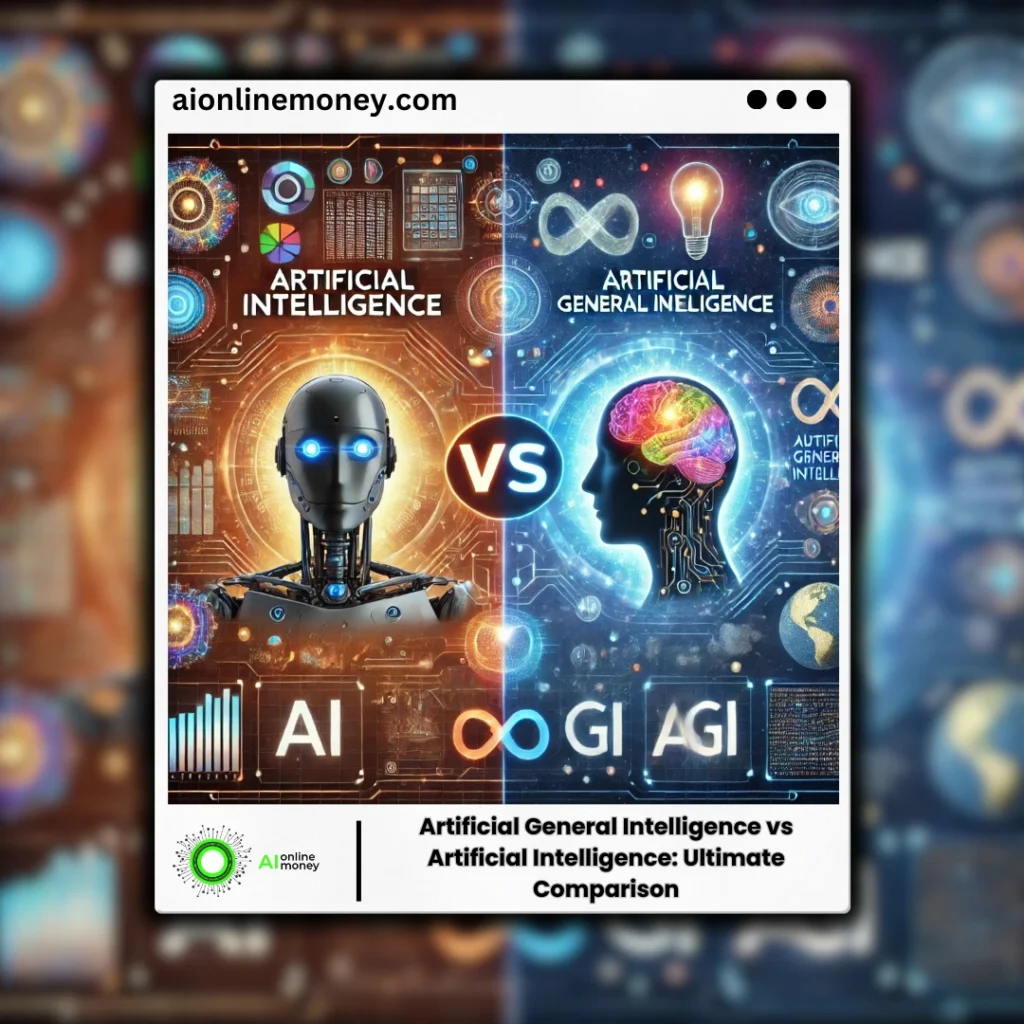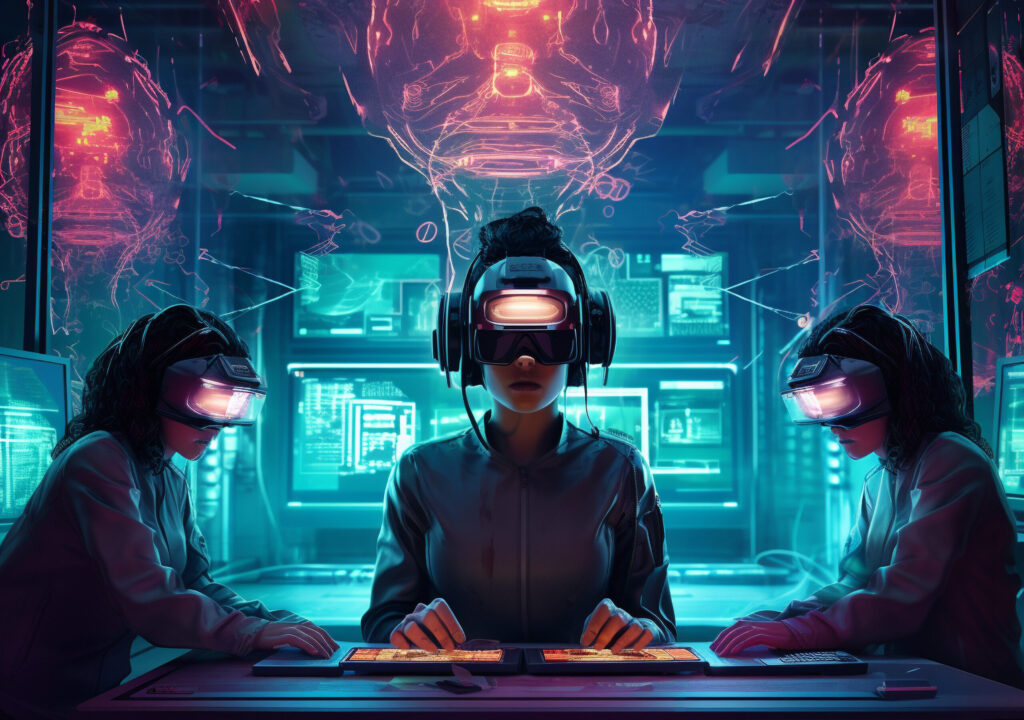Table of Contents
Artificial intelligence (AI) has become a major part of modern life, and this technology changing our lives and updating it daily, from revolutionizing industries, shaping economies, and developing how we interact with technology. In this blog, We will deeply discuss about Artificial General Intelligence vs Artificial Intelligence, While both terms sound similar, But they are different
From each other to their purpose and capabilities. This blog is a detailed understanding of Artificial General Intelligence vs Artificial Intelligence, We will compare their features, and their impact on technology changing our lives.
Artificial General Intelligence vs Artificial Intelligence:
What is Artificial Intelligence (AI)?
Artificial Intelligence this is refer to the simulations of machines that use human intelligence. This AI system is designed to perform particular tasks properly and also surpasses human intelligence in speed and accuracy. Artificial Intelligence has the capacity to process large amounts of data, recognize patterns and also make decisions on pre-programmed algorithms, forward we will see how these technology changing our lives.
AI can be broadly categorized into the following types:
- Narrow AI (Weak AI):
These systems excel at what they’re programmed to do but lack the ability to perform tasks outside their domain. Narrow AI is designed to perform specific tasks, such as voice recognition, translation of a language, etc. Some examples are Siri, Alexa, and Google Translate are examples of Narrow AI systems.
- General AI (Strong AI):
This is where AGI comes into play. General AI refers to systems that can perform any intellectual tasks a human can do. General AI remain a theoretical concept, as this current AI lacks the flexibility and also the understanding of human learning.
What is Artificial General Intelligence (AGI)?
Artificial General Intelligence, also called “Strong AI,” refers to machines with the ability to understand, learn, and apply knowledge across a wide range of tasks at a human or even superhuman level also human intelligence. Unlike Narrow AI, AGI would not require task-specific programming. Instead, it would learn and adapt to new challenges independently.
The characteristics of AGI include:
Flexibility: AGI systems can seamlessly transition between tasks without the need for reprogramming.
Understanding: AGI would exhibit a deep comprehension of concepts and contexts, similar to human reasoning.
Autonomy: Unlike current AI, AGI would learn and improve independently over time, driven by its own goals or objectives.
AGI represents the ultimate goal of AI research and has the potential to revolutionize society of this technology changing our lives. However, it also raises ethical, philosophical, and technical questions. Hope you understand the difference between Artificial General Intelligence vs Artificial intelligence
How AI Works
AI relies on several technologies and methodologies, including:
- Machine Learning (ML):
A subset of AI where algorithms learn from data to make predictions or decisions. For example, spam filters use ML to detect unwanted emails.
- Deep Learning:
A specialized form of ML that uses artificial neural networks to analyze complex patterns. This is commonly used in image recognition and natural language processing (NLP).
- Natural Language Processing (NLP):
Enables AI systems to understand and generate human language. Chatbots and virtual assistants rely on NLP to communicate effectively.
- Computer Vision:
Allows AI systems to interpret and analyze visual information, such as recognizing objects in photos or videos.
- Expert Systems:
AI systems programmed with specific domain knowledge to provide advice or solve problems, like medical diagnosis software.
Challenges of AGI Development
While technology changing our lives, but AI has made significant step, and achieving AGI remains a monumental challenge. Some of the primary problems include:
- Complexity of Human Cognition:
Human intelligence is not fully understood, making it difficult to replicate in machines.
- Resource Requirements:
Developing AGI would require immense computational power, advanced algorithms, and large datasets.
- Ethical Concerns:
Questions surrounding the morality of creating human-like intelligence, its rights, and potential misuse must be addressed.
- Safety:
Ensuring AGI aligns with human values and remains under control is critical. Unchecked AGI could lead to unintended consequences.
- Economic Disruption:
The advent of AGI could render many jobs obsolete, raising questions about its socioeconomic impact.
Applications of Artificial General Intelligence vs Artificial Intelligence:
AI Applications (Current):
- Healthcare: AI assists in diagnostics, treatment planning, and drug discovery.
- Finance: Fraud detection, algorithmic trading, and personalized banking solutions.
- Retail: Customer behavior analysis, inventory management, and chatbots for customer support.
- Transportation: Autonomous vehicles, traffic management, and logistics optimization.
- Entertainment: Content recommendations on platforms like Netflix and Spotify.
Potential AGI Applications (Future):
- Universal Problem Solving: Tackling complex global challenges, such as climate change and disease removal.
- Scientific Research: Accelerating discoveries in physics, biology, and other fields.
- Personalized Education: Creating tailored learning experiences for individuals.
- Space Exploration: Autonomous decision-making in uncharted territories.
- Human-AI Collaboration: Enhancing productivity and creativity across all industries.
Ethical Considerations
The development of both Artificial General Intelligence vs Artificial Intelligence comes with significant ethical concerns:
- Bias in AI:
Current AI systems can inherit biases from training data, leading to unfair outcomes. Developers must ensure transparency and fairness.
- Privacy:
AI systems that collect and analyze user data must protect individual privacy and comply with regulations.
- Job Displacement:
Automation driven by AI could lead to unemployment, necessitating strategies for workforce adaptation.
- AGI Alignment:
Ensuring AGI aligns with human values and goals is critical to prevent potential harm.
- Actual Risks:
The unchecked development of AGI could pose risks to humanity if it surpasses human control.
The Future Ahead
Hope you have understood the difference between Artificial General Intelligence vs Artificial Intelligence, while AI continues to revolutionize industries, AGI remains a work in progress, with much of its potential untapped. Researchers and developers are working toward creating systems that combine AI’s efficiency with AGI’s versatility and this technology changing our lives. However, achieving AGI requires a cautious and collaborative approach to address technical, ethical, and societal challenges.
Conclusion
Artificial General Intelligence vs Artificial Intelligence both represent two sides of the same coin. While AI excels in task-specific applications and has transformed industries, AGI aims to replicate human-like intelligence, holding the promise of unprecedented advancements. Understanding their differences is crucial for shaping the future of technology changing our lives responsibly.
As we move forward, a balanced approach technology changing our lives, innovation, and regulation will be essential to maximize the benefits of Artificial General Intelligence vs Artificial Intelligence while minimizing potential risks. Whether it’s simplifying daily tasks or solving humanity’s greatest challenges, the journey of Artificial General Intelligence vs Artificial Intelligence is just beginning. If you like latest Blogs & News related to AI, then visit at only AiOnlineMoney.



